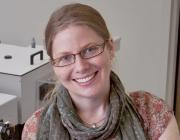The main question of our research is: How do proteins and RNAs work together to build complicated cellular machines? Most importantly, we are investigating the early steps of ribosome formation – a large cellular machine responsible for protein synthesis. Genetic and proteomic studies have implied hundreds of proteins and RNAs to be involved in this complicated process, but we are still lacking a detailed mechanistic understanding of ribosome biogenesis. To generate this knowledge, we are studying the first steps of ribosome biogenesis which is the modification of ribosomal RNA, in particular the formation of pseudouridines. Ultimately, this research may allow addressing further steps on the pathway of ribosome biogenesis.
Stand-alone Pseudouridine Synthases
In all domains of life, stand-alone pseudouridine synthases recognize specific RNA structures and sequences allowing them to site-specifically modify a small number of uridines to pseudouridines. These enzymes differ widely in their substrate recognition, yet have been proposed to employ the same catalytic mechanism. By investigating these enzymes, we aim at unraveling the basic, common features of this enzyme family. For example, we have shown that three representative bacterial pseudouridine synthases all share a uniformly slow catalytic step (J. Wright et al., RNA 2011). This opens questions regarding the evolution of pseudouridine synthases and regarding the catalytic mechanism. We are also studying how the pseudouridine synthases interact with RNA and how they contribute to RNA maturation and folding.
H/ACA small Ribonucleoproteins
In eukaryotes and in archaea, pseudouridine formation is also carried out by complexes of RNA and proteins. These complexes are called H/ACA small ribonucleoproteins and consist of an H/ACA guide RNA as well as four proteins (Cbf5, Nop10, Gar1, and L7Ae/Nhp2). Whereas the H/ACA guide RNA interacts by base-pairing with the substrate RNA, it is the Cbf5 protein which catalyzes the pseudouridylation reaction. Based on the available structural information of this ribonucleoprotein complex, we are investigating the dynamic mechanism of action of H/ACA ribonucleoproteins and their impact on the structure of ribosomal RNA. Therein, we are currently focusing on a well-established archaeal model system enabling sophisticated biochemical and biophysical studies.
Ribosome Biogenesis and Cancer
Ribosome biogenesis is a crucial process for each cell. In particular, fast dividing cells such as tumor cells have a high demand for ribosomes in order to rapidly produce all cellular proteins. Indeed it is a common prognostic tool to stain the nucleolus of potential tumor cells which is the place of ribosome biogenesis: an increased nucleolus indicates rapid cell growth associated with increased ribosome biogenesis. Most likely, up-regulation of ribosome biogenesis is not the cause, but the consequence of the transformation of a normal cell into a tumor cell. But still ribosome biogenesis represents a bottleneck of the rapidly dividing cell. Thus, the pathway of ribosome biogenesis might be an additional target in cancer therapy. By investigating the mechanistic basis of ribosome formation using a powerful and well studies yeast model system allowing for genetic and biochemical studies, our research aims at identifying the critical steps in this crucial cellular process. Thus, we might identify new targets for tumor therapy.
Dyskeratosis congenita
Furthermore, mutations in H/ACA proteins cause an inherited bone marrow failure, Dyskeratosis congenita. Patients suffering from this inherited disease display a variety of symptoms including nail dystrophy, skin abnormalities, increased risk for cancer development and often early death before the age of 30. Since the H/ACA proteins is also part of the human telomerase complex which maintains the chromosome ends, the molecular cause of the disease is unclear. It is actively debated whether Dyskeratosis congenita is caused by a defect in ribosome biogenesis, in telomere maintenances or in both. Our research can directly assess the effects of mutations in H/ACA proteins on their function in ribosome biogenesis. Thus, by using a yeast model system, we will contribute to define the molecular basis of this disease – the first step towards rational drug design.
Methodology
In order to investigate the molecular mechanism of stand-alone pseudouridine synthases and small ribonucleoproteins, we are using a modern, multi-disciplinary approach of molecular biology, biochemistry, biophysics and yeast genetics. Only this combination of techniques will ultimately allow us to obtain a detailed understanding of RNA modification and formation of RNA-protein complexes such as the ribosome. We apply molecular biology to clone the genes of interest and to modify them by site-directed mutagenesis. Subsequently, we recombinantly over-express the proteins in E.coli and purify them by various chromatographic methods. Thereby we can reconstitute active enzymes and ribonucleoprotein complexes in the test tube from highly purified components. This is the basis for further biochemical biophysical studies addressing the function of these complexes. As biochemical assays, we use electrophoretic mobility shift assays, nitrocellulose filtration assays, crosslinking and footprinting. Furthermore, fluorescence measurements allow us to assess the structure, the dynamics and the kinetics of small ribonucleoproteins. By rapid kinetic techniques, we can follow the time courses of RNA modification in real time. Finally, results obtained by these biochemical and biophysical measurements can be verified by genetic studies in the living yeast cell. Eventually, the combination of all these methods will provide us with a detailed understanding of the early steps of ribosome biogenesis


